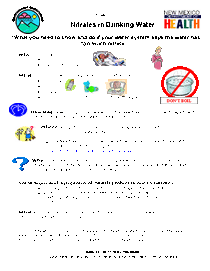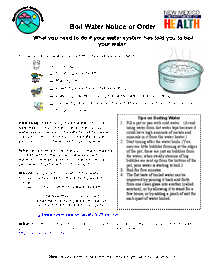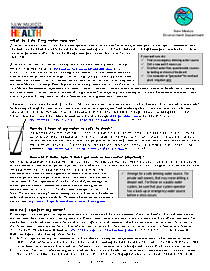Water Quality
Publications
 Sulfate in Drinking Water
Water Quality - Help
January 1, 2007
Sulfate in Drinking Water
Water Quality - Help
January 1, 2007
Sulfate usually occurs naturally in the groundwater in New Mexico because the water dissolves it out of rocks, such as gypsum. Natural levels can be increased by contamination from mines, mills, landfills, sewage and other man-made sources.
 Nitrates in Drinking Water
Water Quality - Guide
February 1, 2006
Nitrates in Drinking Water
Water Quality - Guide
February 1, 2006
What you need to know and do if your water system says the water has too much nitrate.
 Boil Water Notice or Order
Water Quality - Guide
January 1, 2005
Boil Water Notice or Order
Water Quality - Guide
January 1, 2005
What you need to do if your water system has told you to boil your water.
 Nitrate in Drinking Water
Water Quality - Help
September 1, 2003
Nitrate in Drinking Water
Water Quality - Help
September 1, 2003
Nitrate is a chemical compound made up of nitrogen and oxygen, which can be found at low levels in foods (vegetables and meat preservatives) and well water. Nitrate is colorless, odorless, and tasteless. Nitrate can become harmful when bacteria in the environment, food, or in the human body convert nitrate into nitrite.
 Bacterial Contamination
Water Quality - Help
August 1, 2003
Bacterial Contamination
Water Quality - Help
August 1, 2003
Bacteria are living organisms that are too small to see without a microscope. They are present all around us in air, soil, and water. Some types of bacteria can get into drinking water and make people sick.
 Dairies & Human Health Water
Water Quality - Help
August 1, 2002
Dairies & Human Health Water
Water Quality - Help
August 1, 2002
Citizens have expressed some health concerns about living near dairies, especially regarding water quality, air quality, and odor problems.
 Drought
Water Quality - Help
July 1, 2002
Drought
Water Quality - Help
July 1, 2002
The system operators should have a plan for securing an emergency water supply if you are on a public water system. Community water consumers are encouraged to participate in the decision-making process for their community’s drought emergency preparedness.
 Lead in Drinking Water
Water Quality - Help
June 1, 2002
Lead in Drinking Water
Water Quality - Help
June 1, 2002
The Safe Drinking Water Act sets an action level of 15 or less ppb (parts per billion) of lead in drinking water at consumers homes. Drinking water in New Mexico does not naturally contain lead, but lead can get into the water, if lead leaches out of any lead-containing components in the plumbing.

